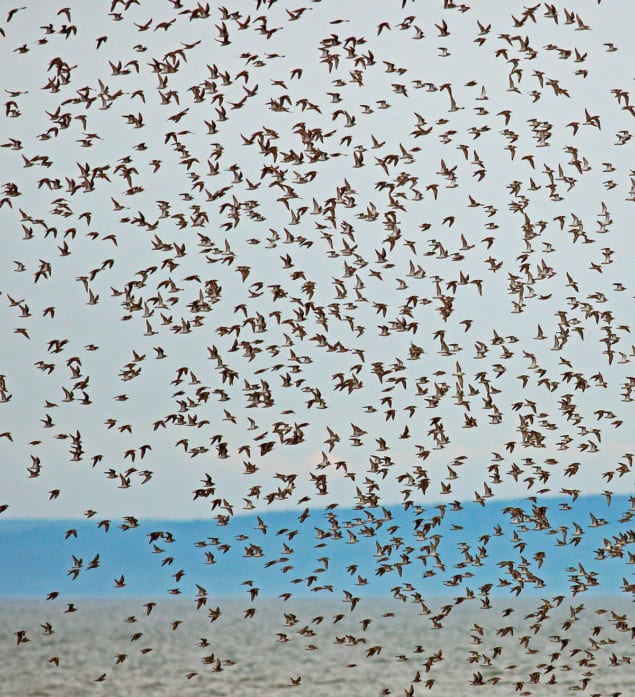
A new report from the Global Warming Policy Foundation (GWPF), more familiar for its critical views on climate change, reviews the impact of wind turbines on the environment and finds that they are “doing great harm to wildlife”. The GWPF says it “does not have a position on wind energy or renewable energy. We neither oppose nor promote it. However, we are in favour of weighing up the pros and cons. Any form of energy production, whether conventional or renewable, has its costs and benefits, and many environmental problems come with every form of energy generation.”
That seems reasonable enough, and the report does include some interesting material. However, the neutral stance might be seen as being abandoned in its second report, looking at renewables generally, under the title “Green Killing Machines”, which pretty much damns them all, including wind turbines.
In the first, more circumspect, report, The Impact of Wind Energy on Wildlife and the Environment, there are contributions from researchers and campaigners focusing on bird and bat impacts, mostly in Germany. It does present some worrying conclusions. For example, Oliver Krüger from the University of Bielefeld describes his research, which concludes that birds of prey and ducks are being killed “in their thousands”. The GWPF says “the risk to these species is so great that there is a possibility of whole populations being wiped out”. It also notes that, according to Peter Henderson of Pisces Conservation, UK, “about 200,000 bats are annually killed at onshore wind turbines in Germany alone. These numbers are sufficient to produce concern for future populations, as bats are long-lived and reproduce slowly, so cannot quickly replace such losses”.
Is it really that bad?
It is true that in the early days of wind energy there were examples of massive impacts on birds at some sites, with some wind farms being poorly sited on bird migration routes, e.g. in southern Spain and in California. But now siting is better and, in some cases, operations are adjusted to avoid nesting periods. That’s not to say collisions don’t happen, for example in Germany, with 29,000 wind turbines, so it is interesting to see what the GWPF report says.
Surprisingly, what stands out from the coverage in the first GWPF report is the relatively low level of bird strikes detected in some of the studies. Oliver Krüger, who was involved with the PROGRESS study of land-based wind turbine impacts on birds in northern Germany, notes that “after walking nearly 7700 kilometres we found 291 collision victims, a rather small number. However, as you know, this is almost certainly just a fraction of the true death toll and so we have to extrapolate”.

UK renewables: a ‘hostile environment’?
After doing that (e.g. taking account of the likelihood that some carcasses are removed by carrion-eaters), the team estimated a median collision rate of 0.47 buzzards or 0.14 red kites per wind turbine per annum. “Now you may be thinking that is nothing, but of course we have to recall that there are many wind turbines,” Krüger says. Grossing up, it was concluded that, while for areas with large and growing bird populations, the impact might result in numbers stabilizing, for areas with small or falling populations “the most likely scenario is that wind turbines will have a population-relevant effect on the buzzard and the red kite”.
Another study covered in the GWPF report looked at forest wind farm sites in Germany and noted that they “can become the only hunting grounds in the open country that are accessible – and thus preferred – to red kites”. The German Wildlife Foundation has called for a moratorium on new wind turbines in forests, to allow for a fuller assessment.
As noted above, there are also problems with bats. The report noted that about 10-12 bats annually are killed at each onshore wind turbine in Germany, and there are serious impacts on their habitat. It’s been argued that wind turbines should not be installed in all types of forest or within a 200 m radius of bat roosts. That sounds sensible, and there are also other measures that can help with this, and with bird impacts.
What can be done?
No-one wants to kill birds, apart from cats, who dispatch up to 3.4 billion a year in the US alone, according to one study. That does not justify killing any more. Same for bats. So countermeasures are important. They include revised operating regimes and acoustic scarers. And some other clever new ideas are emerging. Repowering with bigger turbines might also help significantly — the rotation speed is lower, so presenting less risk of collision and damage.
In addition, good siting, careful planning and public consultation, which the GWPF report claims is weak in some places, notably Ireland, are also vital. The impact scale seems to be worse in the US, where 573,000 bird deaths were reported in 2012, with 51.6 GW of wind turbines in place. Although that has to be put in perspective. This August over 11,000 birds were killed or maimed in a fluke storm of giant hailstones in Montana. Events like that may become more common around the world as climate change impacts more. It is interesting that the UK’s Royal Society for the Protection of Birds (RSPB) has said that climate change will be a far bigger problem for birds than wind farms.

Penguin physics
Nevertheless, there clearly can be problems. For example, there have been reports of knock-on local ecosystem impacts with wind turbine arrays in India, due to the resultant reduction in the abundance and activity of some predatory bird populations — they move elsewhere. India does have some very large wind farms; the largest so far has 3000 turbines. China has an even larger one, with around 7000 turbines and more planned, taking it to 20 GW. Projects on this scale clearly need careful impact assessment. We can’t have expansion at all costs.
A bug’s life
The GWPF report also opens up a new front: impacts on bugs, which, it seems, hit wind turbine blades in large numbers in most locations. In the introduction to the GWPF report, Fritz Vahrenholt from the German Wildlife Foundation says “initial studies estimate that about 1200 billion migratory insects (or 3600 tons) are killed in this way”– 5% of the migrating insects. “The German Wildlife Foundation will be researching whether there is a correlation between the rapid expansion of wind turbines and the estimated decrease of flying insects by 75% in the last 20 years…,” he noted. “Is it agriculture? The clearing of land? Monocultures? Or could it be linked to another potential cause, namely wind turbines? If that were the case, there would be an important indirect effect on the nutritional foundations for birdlife. This would represent another impact of wind turbines on birds.”
It’s hard to see how wind turbines could be responsible for much of this but clearly there are some unresolved issues in relation to wind and, in parallel with the wind impact report, GWPF has also waded in with a review of biomass. It focuses on the DRAX wood pellet-fired combustion plant in Yorkshire, UK, and its use of imported forest-derived products, perhaps an easier target. Many environmental groups oppose this approach.
None of the above
However, when the GWPF pulls all this together in its broader Green Killing Machines review of the impacts of all the renewables, its views diverge strongly from that of most environmental groups. But then the GWPF damns just about all of them, complaining that “RSPB barely opposes a development. Wind and solar power plants scar our landscapes and yet the CPRE [Campaign to Protect Rural England] say nothing either”. The GWPF press release says “Net zero carbon emissions will mean a vast expansion of wind and solar farms together with massive expansion of biofuel crops cultivation causing wholesale devastation of the UK’s landscape and wildlife”.
With the CPRE called out strongly, including in a linked GWPF video, using the Hinkley nuclear plant as a template, we can expect an extended battle…with also an odd synchronicity, as Putin expresses his concerns about wind power’s impacts on birds.
In the past, the GWPF has backed some quite critical studies of wind power economics and operation, comparing it, and most renewables generally, unfavourably with nuclear power. Now it has moved on to environmental impacts, while professing (in the wind report) that: “We are not opponents of wind energy. Where wind energy makes sense it should be used. Wherever it is unreasonable and destructive, it should be avoided.”
It’s hard to gainsay that, and it is fair enough to give wind power a critical assessment, as in the first report, even though views from supporters would have been good. But there is an escalating tone of hostility. The GWPF’s press release for the wind report talks of “the appalling environmental cost of wind energy”, while the wider report’s summary says, sweepingly, “far from making the world a better place, renewable energy will destroy all we hold dear”.
In the meantime, the last full UK government Department for Business, Energy & Industrial Strategy (BEIS) national poll found that public support for renewables overall was at 84%, while 79% of people surveyed in the UK supported onshore wind. Certainly pressure for its expansion, as one of the cheapest renewables, has been building, with the Select Committee on Science and Technology now also coming out in favour. The GWPF may have to worry about another type of collision, this time one of opposing views.



